Simple ingredient offers multiple benefits to freshwater fish farmers
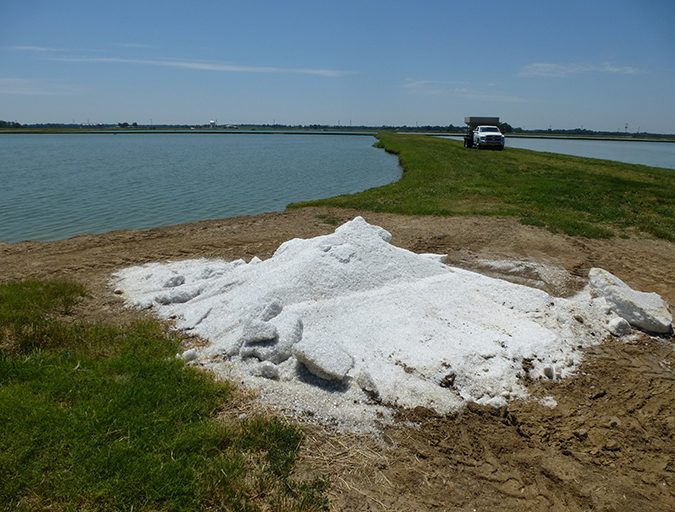
Editor’s note: This is part 2 of a two-part series. To read part 1, click here.
Salt to prevent or treat fish eggs infections
The control of fungal infections on fish eggs can be accomplished with salt baths at 20 to 30 ppt for 10-15 minutes daily or on alternate days. In recirculating systems for incubating tilapia eggs or other freshwater fish species, maintaining salt concentrations around 3 to 5 ppt will minimize fungal infection on eggs and on newly hatched fry. In addition, for fry first feeding on Artemia nauplii, live food will be available longer at 2-4 ppt salinity than in freshwater.
Salt to control external parasites
Many protozoans, dinoflagellates and monogeneans parasites can be controlled with short, concentrated salt baths (see Table 1 for recommendations on concentrations and duration of suggested treatments). Infection and inflammation in fish gills and skins result in fish losing salts and overhydrating. Thus, bathing fish in salted water not only dehydrates the parasites to death, but also allows fish to rapidly restore sodium and chloride ions to the blood. After a short time of a high concentration salt bath, and if possible, fish should be kept at least one extra day in water salted at 5 to 6 ppt before being moved to the production units or to other farms. When deciding to use salt to control infections in fish, farmers need to learn how each species will behave and tolerate the salt treatment. Possible effective timing and dosing should be first tested on a small number of fish and adjusted accordingly, especially when new species are to be treated. In addition, it is necessary to properly plan the treatment and have adequate skills and equipment to perform it. Having a microscope at a farm and knowing how to look for parasites on a skin or gill smear will also help to assess the degree of infection and the treatment effectiveness. This will save labor, time and money by avoiding ineffective treatments and waste of chemicals, and prevent headaches and sleepless nights thinking of your dying fish.
Salt baths at 20 to 30 g/L for 10 to 30 minutes (or until the fish start to lose their equilibrium) can be applied. If infections are heavy, it may be necessary to repeat the treatment at 1-2 day intervals. Normally, three to four baths are required to effectively control some tougher parasites. Treating fish with salt in raceways or cages is relatively easy and has a low cost. In raceways, the water flow is shut off and the fish are crowded at one end, then enclosed with a vinyl curtain or a solid board into a smaller volume of water, which reduces the amount of salt required. Salt is then added to reach the desired concentration. Supplemental aeration is needed during the treatment. When the treatment is finished, the salt concentration can be brought down rapidly by simply removing the curtain or board and by restarting the water flow through the raceway. Treating fish in cages requires the enclosure of the whole cage within a vinyl wrap (Figure 4).
Salt is a safe, effective and affordable product to prevent losses of farmed freshwater fishes. As we have seen, there are many ways in which common salt can be effectively used in freshwater aquaculture farms.
Applying salt to a whole pond to control fish parasites is too costly and technically unfeasible, as it requires large amounts of salts and water to rapidly dilute salt concentrations after treatment. It is worth mentioning a salt treatment we performed to control a severe Piscinoodinium infection on juveniles of Dourado (Salminus brasiliensis), a valuable native fish in Brazil. As the fish were in a 1,000 m2 pond we had to first harvest them, then apply a single and effective salt treatment, and then transfer them to a newly filled pond. We opted for a 3-min, highly-concentrated salt bath (50 g salt/L or 50 kg salt/m3). We first tested this salt bath treatment on a group of 50 infected fish to observe their reaction and how effective the salt treatment would be to control the parasites. Fish started to swim erratically and had spasms immediately after being placed in the salt bath, and released large amount of mucus. Water started to foam due to excess mucus and the strong aeration applied. In less than a minute, all the fish were laying on their sides at the bottom of the tank, and we all thought the fish would not survive. We kept them for 3-min in the salt bath as planned, and then rapidly moved the fish back to freshwater.
Surprisingly, the fish slowly recovered and all of them survived the bath. We observed the skin and gills smears of some fish under the microscope and noticed that most of the parasites were gone, probably with the mucus that had sloughed off the fish. The few parasites still remaining on the fish were motionless, certainly dead. On an extreme infection and treatment like this one, it seems to be a matter of who tolerates the treatment longer: the fish or the parasites. Parasites are tiny organisms very exposed to water and tend to dehydrated faster and die first than fish in salt baths.
This initial test gave us confidence to apply the treatment to the whole population of fish. We seined half of the pond and rapidly loaded the fish into two hauling tanks with salted water at 50 kg salt/m3 and hapas and oxygen diffusers assembled inside (Figure 5). Fish behaved exactly the same way we have seen previously during the test. After 3-min in the salt bath, we rapidly transferred the fish to a hapa set up in a new pond. By lowering one side of the hapa under the water, we could observe the fish recover and swim freely into the pond. Very few dead fish remained in the hapa. Then, we repeated the process seining the whole pond and treating the second batch of fish the same way. Fortunately, nearly all the fish survived the treatment and the Piscinoodinium infection was effectively controlled with this single and highly concentrated salt bath.

Salt for preventing nitrite poisoning
Nitrite (NO2-) is toxic to fish. Ammonia generated by fish and decomposing organic matter undergoes a microbial nitrification process to produce nitrites. Nitrite levels above 0.3 mg/L require attention, since fish performance and immunity may start to be impaired. Toxic nitrite levels generally above 0.7 mg/L, depending on the species and water chemistry, are common in intensively fed, static ponds. Increased chloride concentration in water through salt application is an effective way to prevent nitrite toxicity. Common salt is 60 percent chloride, and chloride ions bind to nitrite cell receptors on the gills, preventing nitrite ions from being absorbed by the fish. In ponds, farmers need to maintain a ratio of chloride to nitrite of at least 6:1. Boyd (1998) suggested a simple equation to determine the amount of salt (in g/m3) that should be applied to a pond, according to the expected nitrite levels and actual concentration of chlorides in pond water.
Salt dose (g/m3) = [6 x (NO2– mg/L) – (Cl– in water mg/L)] / 0.6
Consider a pond where chloride levels are nearly zero and nitrite is expected to a maximum of 1 mg/L. The dose of salt to be applied to the pond should be at least [(6 x 1) – (0)] / 0.6 = 10 g salt/m3. Thus, for a 1-ha (10,000 m2) pond with an average depth of 1.5 m (volume = 10,000 m2 x 1.5 m = 15,000 m3), the amount of salt to be applied should be at least 150 kg. As one can see, the amount of salt required to prevent nitrite toxicity in fish ponds is relatively small. However, if water has already high levels of chlorides, the application of salt may not necessary, saving time and money to farmers. For this reason, farmers should have on hand a water quality test kit to determine chloride concentrations in the water.
In biofloc or intensive recirculating systems, nitrite levels can often be higher than 20 mg/L. A salt concentration of 3 ppt minimizes the risk of infection by fungi and external bacteria, and is more than enough to prevent nitrite toxicity. I have observed a tilapia and biofloc tank that momentarily reached 480 mg NO-2/L. Fish mortality in that tank was prevented because salt was added at 3.3 kg/m3 at the beginning of the culture cycle. The ratio Cl:NO2– in that tank was estimated at nearly 4:1.
Salt to prevent environmental gill disease
Environmental gill disease is a condition of injury, inflammation and irritation of the gill epithelia that can be caused by irritating chemicals (formalin, potassium permanganate, calcium oxide and others), excessive suspended solids (clay, fish feces, biofloc, feed wastes, plankton, etc.) or a combination of these. Parasites (trichodinids, monogeneans, dinoflagellates, myxosporeans, among others) and bacterial infections also can cause gill diseases. Myxosporeans may cause severe necrosis, inflammation and bleeding of the gills (proliferative gill disease or “hamburger gill”). Gill diseases make it difficult for the fish to breathe, osmoregulate and excrete ammonia. Rearing fry and fingerlings in high density systems may expose fish to many of these factors which favor the occurrence of environmental and bacterial gill diseases. Therefore, preventive salt baths, at 8-10 ppt for 2-4 hours), especially after cleaning the tanks, will increase mucus production and slough off excess organic debris, parasites and bacteria from the gills, helping to reduce gill inflammation, preventing further infections and improving overall condition, health and survival of the fish in these intensive systems.
Use of salt to improve fish survival in cages
Chronic and acute mortalities are very common in cage culture of freshwater fish. Mortalities peaks are common in the first week upon arrival of the fingerlings to the cages, and also at more advanced stages after the fish are graded and transferred to other cages. Crowding in the nets and handling stress cause fish to lose large amount of salts to the water and depresses the fish immune response. Rough handling causes the fish to lose mucus and scales and damages their skins, facilitating infection by fungi and opportunistic bacteria. Farmers need to invest time and money to train workers and adapt their facilities to improve fish handling and survival. Fish mortality can be substantially minimized with the preventive and proper use of salt. Upon arrival at the farm fingerlings can be treated for parasites and held for 4-5 days in tanks with salted water at 5 to 6 ppt, allowing them to recover from the transport stress (see Figure 3 in Part 1). The handling of juvenile fish for grading and restocking in other cages should be performed as much as possible in tanks with water salted at 5 to 6 ppt (Figure 6). If not possible, fish could be alternatively kept in cages enclosed in a vinyl wrap, with water salted at 5-6 ppt for 10-12 hours after handling. Aeration inside the enclosure is needed. Keeping fish in salted water results in the animals quickly restoring blood salts, and, also in the production of excess mucus to heal skin lesions and to prevent opportunistic infections by fungi or bacteria.
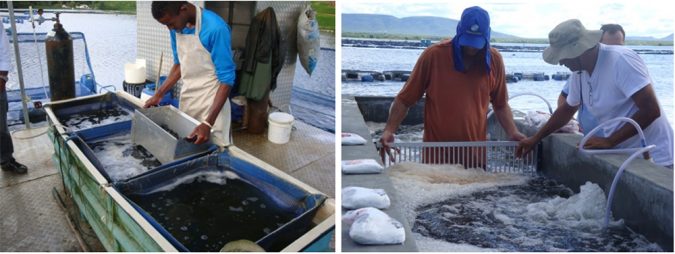
Feeding pellets supplemented with salt (15 g of salt/kg of pellets) for 2-3 days after handling and transferring the fish is another effective way for fish to rapidly restore normal salt levels in their blood. This practice has already been adopted in some tilapia cage farms in Brazil, as it reduces fish mortality after handling. In large scale farms, salt-enriched pellets can be manufactured to order by feed mills. And at small farms, salt can be added to the feed using a cement mixer (Figure 7). Salt is dissolved in water and evenly distributed over the pellets using a garden watering can, at 150 g of salt in 1.0 to 1.5 L of water for 10 kg of floating pellets.
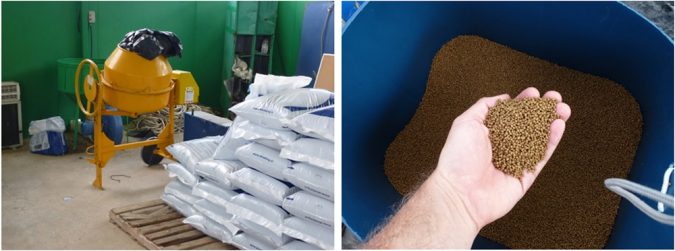
Proper salt balance in feeds may improve condition and growth performance of fish
Freshwater fish normally spent 10-15 percent of their energy from food on osmoregulation. Fish confined in cages may spent even more, since the high stocking density and strong competition for pellets further increase salt losses due to peaks of cortisol in fish blood. Cortisol increases permeability of cell membranes to water and salts, making fish overhydrate and lose more salts to water. Salt losses can be readily compensated if feeds have proper amounts and combination of salts, especially the monovalent ions Na+, Cl+ and K+. A salt balanced feed may help fish to save energy from osmoregulation and use it for additional growth and, possibly, for other important physiological needs, such as immune defense. Feeding studies with hybrid tilapia (O. niloticus vs. O. aureus) in freshwater demonstrated that the growth rate can be improved by 17-20 percent and feed efficiency by 14-23 percent by adding sodium, chloride and potassium to the feeds (Shiau and Hsieh 2001; Shiau and Lu 2004; Cnaani et al 2010). Some feed manufacturers in Brazil are already improving the balance of salts in feeds for tilapia farmed in cages.
Final remarks
Discharge of salted water to receiving waters, though, is an issue that farmers need to consider when using salt in freshwater aquaculture. Another issue is corrosion of metallic equipment and other infrastructure that may need special protection and maintenance. Other than that, salt is a safe, effective and affordable product to prevent losses of farmed freshwater fishes. As we have seen, there are many ways in which common salt can be effectively used in freshwater aquaculture farms. Timing and dosing are key issues in salt treatments, as they are for any other chemicals applied to water. Fish farmers should further increase their understanding on the proper use of common salt and its benefits.
Now that you've reached the end of the article ...
… please consider supporting GSA’s mission to advance responsible seafood practices through education, advocacy and third-party assurances. The Advocate aims to document the evolution of responsible seafood practices and share the expansive knowledge of our vast network of contributors.
By becoming a Global Seafood Alliance member, you’re ensuring that all of the pre-competitive work we do through member benefits, resources and events can continue. Individual membership costs just $50 a year.
Not a GSA member? Join us.
Author
-

Fernando Kubitza, Ph. D.
Acqua Imagem Serviços Ltda.
Rua Evangelina Soares de Camargo, 115
Jardim Estádio – Jundiai/SP – CEP 13203-560 Brazil[114,98,46,109,111,99,46,109,101,103,97,109,105,97,117,113,99,97,64,111,100,110,97,110,114,101,102]
Tagged With
Related Posts
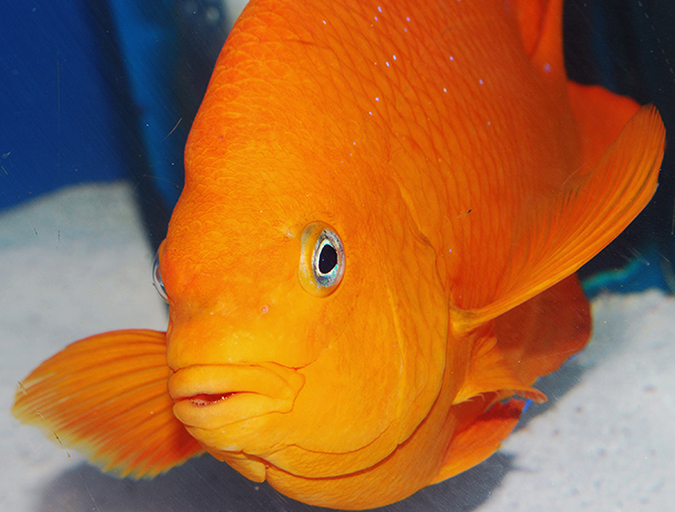
Aquafeeds
The importance of carotenoids in aquafeeds
Carotenoids are important pigments that contribute characteristic quality criteria for the marketing of aquaculture products. Aquatic animals cannot biosynthesize carotenoids de novo, hence their inclusion in aquafeeds is important because they are associated with various metabolic functions.
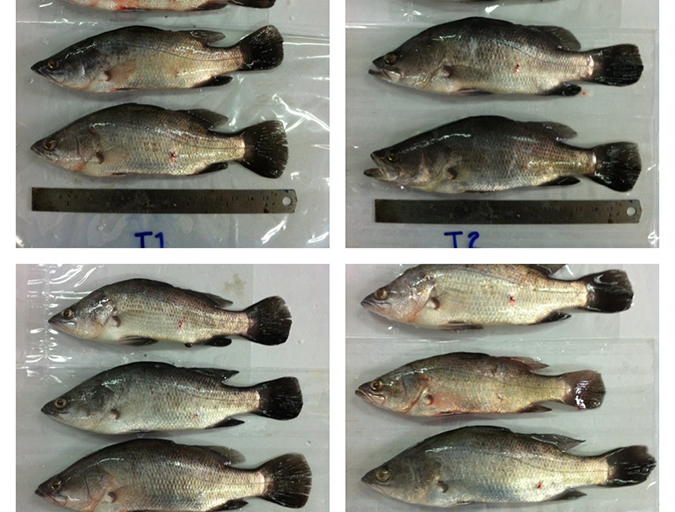
Aquafeeds
Improving productivity, efficiency in Asian sea bass aquaculture
The effects of the dietary acidifier and feed additive potassium diformate (KDF) were tested in diets of juvenile Asian seabass (Lates calcarifer) in Thailand. Results show that including KDF at 0.5 percent in the diets can help improve growth, survival and therefore overall production of this species.
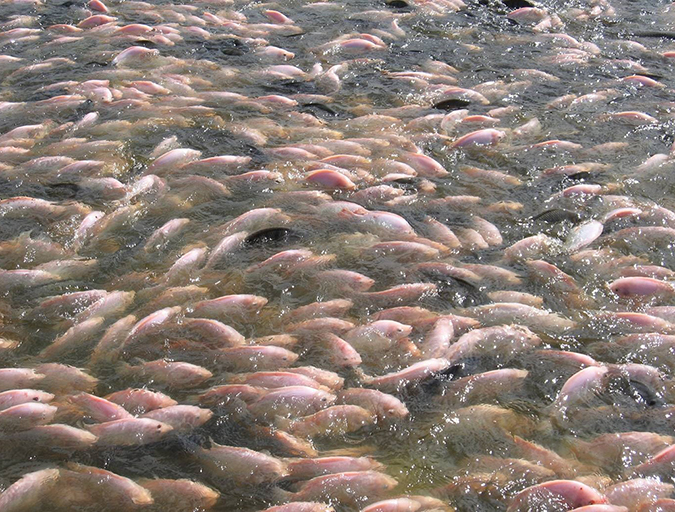
Health & Welfare
Common salt a useful tool in aquaculture, part 1
The preventive use of common salt (sodium chloride) by commercial producers of freshwater fishes has many benefits, including helping with the routine prevention of losses due to diseases, stress and mishandling during transport, harvesting, grading, counting, weighing and induced spawning.
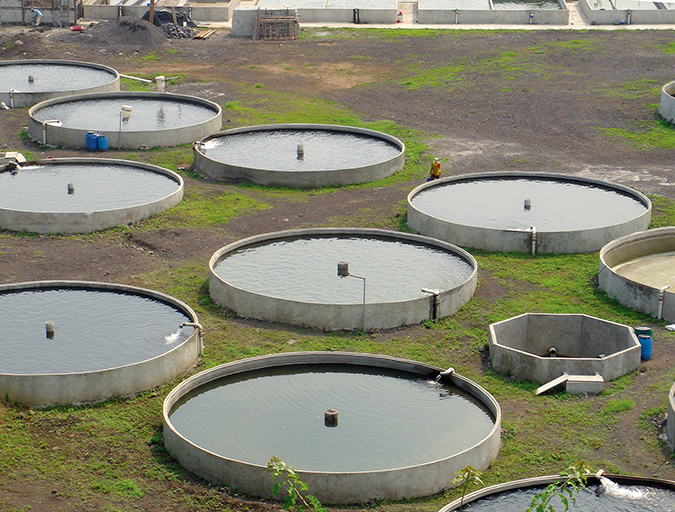
Responsibility
Calcium and magnesium use in aquaculture
Aquatic plants and animals get the essential nutrients calcium and magnesium from water and food. Calcium concentrations impact the hydration and development of eggs in a hatchery, where calcium carbonate precipitation can be troublesome.


